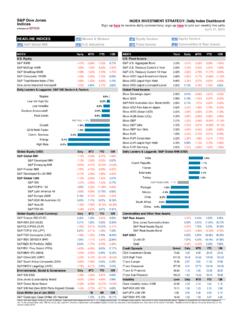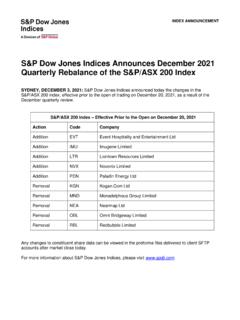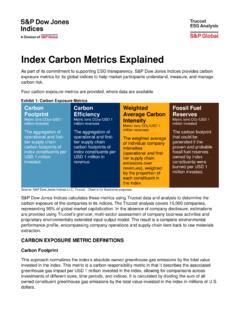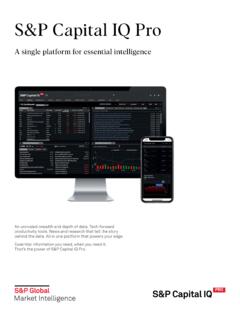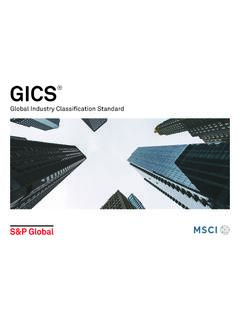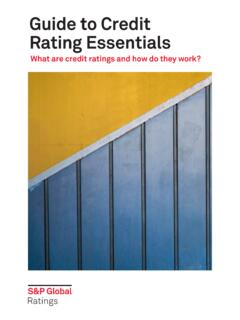Transcription of S&P U.S. Indices - S&P Global
1 January 2023 S&P Dow Jones Indices : Index Methodology S&P Indices Methodology S&P Dow Jones Indices : S&P U. S. Indices Methodology 1 Table of Contents Introduction 3 Index Objective 3 Highlights and Index Family 3 Supporting Documents 5 Eligibility Criteria 6 Eligibility Factors 6 Index Construction 11 S&P Total Market Index 11 S&P 500, S&P MidCap 400 and S&P SmallCap 600 11 S&P Composite Indices 11 S&P 100 12 S&P 500 Top 50 12 S&P Completion Index 12 Select Sector Indices 12 Index Calculations 14 Approaches 14 Shares Outstanding 14 Index Maintenance 15 Timing of Changes 15 Deletions 16 Share and IWF Updates 16 Corporate Actions & Rebalancing Guidelines 16 Other Adjustments 16 Currency of Calculation and Additional Index Return Series 16 Base Dates and History Availability 17 Index Data 19 Calculation Return Types 19 Index Governance 20 Index Committee 20 Index Policy 21 Announcements 21 Holiday Schedule 21 S&P Dow Jones Indices : S&P U.
2 S. Indices Methodology 2 Rebalancing 21 Unexpected Exchange Closures 21 Recalculation Policy 21 Real-Time Calculation 21 Contact Information 21 Index Dissemination 22 Tickers 22 Index Alert 23 Index Data 23 Web site 23 Appendix A 24 Historical Market Capitalization Guidelines 24 Appendix B 25 Index Construction and Weighting Information for Certain Derived Indices 25 S&P Select Sector Capped 20% Indices 25 S&P Select Sector Daily Capped 25/20 Indices 27 S&P Select Sector 15/60 Capped Indices 29 S&P Select Sector 15/40 Plus Capped Indices 31 S&P 500 Consumer Select 15/60 Index 33 S&P 500 Capped 35/20 Indices 35 S&P MidCap 400 Capped Sector Indices 37 S&P SmallCap 600 Capped Sector Indices 39 S&P 500 Ex-Sector Indices 41 S&P Composite 1500 / S&P TMI (Spliced as of EOD Dec-18-2015) Index 41 S&P 500 Ex-Financials, Real Estate, Utilities and Transportation Index 41 S&P Equal Weight Indices 41 S&P 900 Banks (Industry) 7/4 Capped Index (USD) 43 S&P 500 in TTM Rates JPY Hedged Index 44 Appendix C 45 Methodology Changes 45 Appendix D 53 EU Required ESG Disclosures 53 Disclaimer 54 Performance Disclosure/Back-Tested Data 54 Intellectual Property Notices/Disclaimer 55 S&P Dow Jones Indices : S&P U.
3 S. Indices Methodology 3 Introduction Index Objective The S&P Indices are a f amily of equity Indices designed to measure the market performance of domiciled stocks trading on exchanges. The f amily is composed of a wide range of Indices based on size, sector, and style. The Indices are weighted by float-adjusted market capitalization. In addition, equal weighted and capped market capitalization weighted Indices are also available as detailed below. Highlights and Index Family Float-Adjusted Market Capitalization Weighted Indices : S&P Total Market Index. The index measures the performance of the broad market and includes all eligible common equities. S&P 500. The index measures the performance of the large-cap segment of the market. Considered to be a proxy of the equity market, the index is composed of 500 constituent companies. S&P MidCap 400. The index measures the performance of the mid-cap segment of the market. The index is composed of 400 constituent companies.
4 S&P SmallCap 600. The index measures the performance of the small-cap segment of the market. The index is composed of 600 constituent companies. S&P Composite Indices . The Indices include the S&P Composite 1500, S&P 900, and S&P 1000. The S&P Composite 1500 is a combination of the S&P 500, S&P MidCap 400, and S&P SmallCap 600 and measures the performance of all three market size segments. The S&P 900 is a combination of the S&P 500 and S&P MidCap 400 and measures the performance of the mid- and large-cap market size segments. The S&P 1000 is a combination of the S&P MidCap 400 and S&P SmallCap 600 and measures the performance of the mid- and small-cap market size segments. S&P Completion Index. The index is a sub-index of the S&P Total Market Index and measures the perf ormance of all constituents in the S&P Total Market Index that are not also constituents of the S&P 500. The Index is constituted at the company level, not at the share line level.
5 If one company listing is in the S&P 500, all other company listings are excluded from the S&P Completion Index. S&P 500 Top 50. The index measures the performance of 50 of the largest companies in the S&P 500, based on float-adjusted market capitalization. S&P 100. The index measures the performance of 100 companies selected from the S&P 500. Generally, the largest companies in the S&P 500 that have listed options are selected for index inclusion. Sector balance is also considered in the selection of companies for the S&P 100. See Appendix B for additional details on the following Indices : S&P Composite 1500 / S&P TMI (Spliced as of EOD Dec-18-2015) Index. The index is a replica of the S&P Total Market Index and follows the S&P Total Market Index methodology with the exception that for index history prior to December 18, 2015, the index was a replica of the S&P Composite 1500 and followed that index s methodology. S&P Dow Jones Indices : S&P U.
6 S. Indices Methodology 4 S&P 500 Ex-Sector Indices . The Indices measure the performance of all companies in the S&P 500, excluding those companies in one or more defined sector(s). Company classifications are based on the Global Industry Classification Standard (GICS ). S&P 500 Ex-Financials, Real Estate, Utilities and Transportation Index. The index measures the perf ormance of all companies in the S&P 500, excluding those belonging to the Financials sector, Real Estate sector, Utilities sector or Transportation industry group. Company classifications are based on GICS. S&P 500 Communication Services & Information Technology Index. The index1 measures the perf ormance of companies in the S&P 500 classified as part of the Communication Services and Inf ormation Technology sectors. Company classifications are based on GICS. For more information on GICS, please refer to S&P Dow Jones Indices Global Industry Classification Standard (GICS) Methodology.
7 Equal Weight Indices : S&P Equal Weight Indices . The Indices include the S&P 100 Equal Weight Index, S&P 500 Equal Weight Index, S&P 500 Equal Weight Sector Indices , S&P MidCap 400 Equal Weight Index, S&P MidCap 400 Equal Weight Sector Indices , S&P SmallCap 600 Equal Weight Index, S&P SmallCap 600 Equal Weight Sector Indices , S&P Composite 1500 Equal Weight Index, and S&P Composite 1500 Equal Weight Sector Indices . Index composition for these Indices is the same as that of their respective underlying index. Each company is equally weighted as of the respective rebalance reference date, rather than weighted by float-adjusted market capitalization. Unless otherwise noted in Index Construction, index constituents for the Equal Weight Sector Indices are drawn from their respective parent Indices and selected for index inclusion based on their GICS classification. Capped Market Capitalization Weighted Indices : S&P Capped Market Capitalization Weighted Indices .
8 The Indices include the Select Sector Indices , S&P Select Sector Capped 20% Indices , S&P Select Sector Daily Capped 25/20 Indices , S&P Select Sector 15/60 Capped Indices , S&P 500 Capped 35/20 Indices , S&P MidCap 400 Capped Sector Indices , and S&P SmallCap 600 Capped Sector Indices . Index constituents are drawn f rom their respective underlying index ( , the S&P 500, S&P MidCap 400 or S&P SmallCap 600) and selected for index inclusion based on their GICS classification. Instead of weighting by float-adjusted market capitalization, the Indices employ a capped market capitalization weighting scheme and specific capping methodology. 1 S&P Dow Jones has created back calculated history for the index based on the securities in the headline S&P 500 that would have hypothetically been classified as GICS Code 50 and 45 under this new structure effective September 24, 2018. S&P Dow Jones Indices : S&P U. S. Indices Methodology 5 Supporting Documents This methodology is meant to be read in conjunction with supporting documents providing greater detail with respect to the policies, procedures and calculations described herein.
9 References throughout the methodology direct the reader to the relevant supporting document for further information on a specific topic. The list of the main supplemental documents for this methodology and the hyperlinks to those documents is as follows: Supporting Document URL S&P Dow Jones Indices Equity Indices Policies & Practices Methodology Equity Indices Policies & Practices S&P Dow Jones Indices Index Mathematics Methodology Index Mathematics Methodology S&P Dow Jones Indices Float Adjustment Methodology Float Adjustment Methodology S&P Dow Jones Indices Global Industry Classif ication Standard (GICS) Methodology GICS Methodology This methodology was created by S&P Dow Jones Indices to achieve the aforementioned objective of measuring the underlying interest of each index governed by this methodology document. Any changes to or deviations from this methodology are made in the sole judgment and discretion of S&P Dow Jones Indices so that the index continues to achieve its objective.
10 S&P Dow Jones Indices : S&P U. S. Indices Methodology 6 Eligibility Criteria Securities must meet the following eligibility factors to be considered eligible for index consideration. As applicable, the measurement date for determining whether all eligibility criteria are met for the S&P Composite 1500 is the open of trading on the day prior to the announcement date: Eligibility Factors Domicile. Only common stocks of companies are eligible. For index purposes, a company has the f ollowing characteristics: 1. Files 10-K annual reports. 2. The portion of fixed assets and revenues constitutes a plurality of the total but need not exceed 50%. When these factors are in conflict, fixed assets determine plurality. Revenue determines plurality when there is incomplete asset information. Geographic information for revenue and f ixed asset allocations are determined by the company as reported in its annual f ilings. 3. The primary listing must be on an eligible exchange as described under Exchange Listing below.

